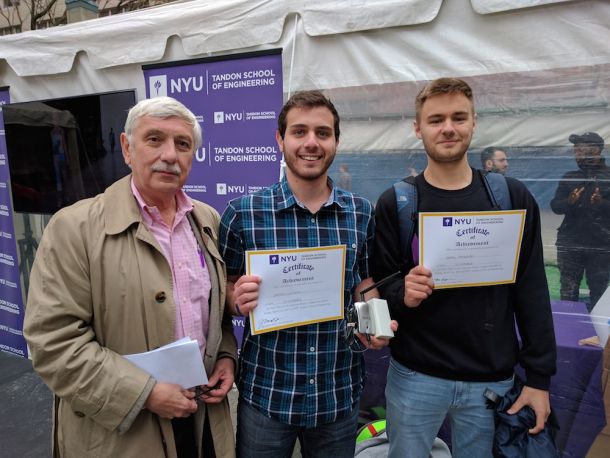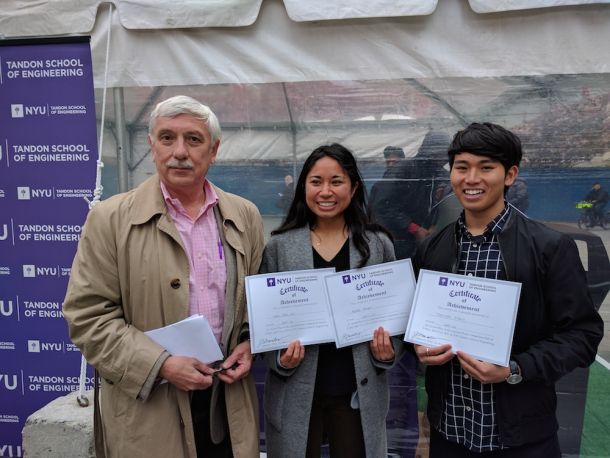Senior Projects Garner Awards at Capstone Competition
Winning teams tackle bicycle safety, support business growth, and take flight
A student designed and manufactured aircraft that took third place in the Senior Capstone Competition
As dozens of student and faculty researchers gathered at NYU Tandon School of Engineering’s 2017 Research Expo to display their innovative research, senior undergraduate students also presented their culminating capstone projects as part of the second annual Senior Capstone Competition, sponsored by the Convergence of Innovation and Entrepreneurship (CIE) Institute. The competition gives undergraduates a unique opportunity to hone their entrepreneurial skills as well as the chance to win cash prizes to fund future endeavors on their projects.
Six teams were selected by the capstone competition committee, which included industry professor Michael Knox and associate professor of chemical and biomolecular engineering and CIE Institute director Jin Montclare, to pitch their prototypes to a panel of judges at the Research Expo. The judges — who included Justin Hendrix, the executive director of NYC Media Lab; Ali Heron, senior vice president of engineering at Two Sigma; Lee von Kraus, the founder of Nebulab; and Ananda Ghosh, technology marketing associate at NYU Office of Industrial Liaison — critiqued the teams on their projects’ technical achievement, novelty, and impact. The final three teams were awarded monetary prizes: $1,500 for first place, $750 for second place, and $500 for third.
First Place

Kurt Becker, Vice Dean for Research, Innovation and Entrepreneurship, awards first place to Dimitrios Lintzeris and Daniel Targonski, seniors in electrical engineering, for their autonomous pedestrian tracking device
First place winners Dimitrios Lintzeris and Daniel Targonski, both majors in electrical engineering, created a fully autonomous pedestrian traffic counter that tracks and gathers data on the amount of people passing by a business during a day. Many businesses rely on manual customer count reports to determine new store locations, but with current reports only tracking customers and pedestrians at specific times during the day, Lintzeris and Targonski wanted to create a more automated device. “We can make a better, more precise version of customer counts and give businesses estimates of passerbys throughout the whole day,” Lintzeris said. Built with a raspberry pi and a 3D printed case, the wireless device tracks a phone’s unique wifi address as it passes a store. With the collected data, Lintzeris and Targonski’s device can help companies to tailor advertising and help with forecasting sales.
Second Place

Kurt Becker with second place winners, Aimee Nogoy, Takuya Fukui, and Wai San Gu (not pictured) for their project RadarWAT, which uses sensors to alert bicyclists of close-approaching vehicles
The statistics are staggering for deaths resulting from collisions between bicyclists and motor vehicles. With an estimated 40% of these fatalities occurring after a car crashed into a bicyclist from behind, electrical engineering students Aimee Nogoy, Takuya Fukui, and Wai San Gu created the safety device RadarWAT to alert cyclists to cars that are approaching too closely behind their bicycle. Optical ranging sensors attached to the back of the bicycle seat measure the distance from the back of the bicycle to the closest vehicle. If the car is closer than set parameters, the sensors communicate with a wrist device to trigger a vibration alarm to notify the cyclist. Inspired by the New York City Vision Zero Initiative, RadarWAT aims to help protect cyclists as they navigate busy and congested streets and in ensuring the safety of cyclists and drivers.
Third Place

Kurt Becker congratulates Katrina Johnk, member of the SAE Aeroplane team and senior in mechanical engineering and computer science.
The third place prize went to Frederick Bills, Artur Chodor, Bartosz Chodor, Garrett Harbeson, Sakir Hossain, and Katrina Johnk, who designed and manufactured an aircraft for the Society of Aerospace Engineers (SAE) Aero Design East 2017 competition. The annual competition challenged students to engineer a model passenger aircraft that maximizes the passenger and cargo load, while minimizing power consumption. Featuring a dual-airfoil wing, an octagonal fuselage and staggered passenger seating arrangement that resulted in less drag, the team’s design placed 15th out of 40 teams in the regular competition class, and secured 14th place for the Highest Payload — a feat for many of the team members in their first foray in aeroplane design. “The competition was hugely rewarding, and it is our hope that Tandon continues to send teams in the future,” Johnk said. “If we were to compete again, we would probably take a lot more risks design-wise. We believe, though, that we struck a good balance between simplicity and creativity.”
For students preparing for their senior capstone projects next year, Montclare hopes their ventures are guided by the spirit of innovation. “With all the new programs at the Convergence for Innovation and Entrepreneurship Institute, I hope that students begin to expand out from their own disciplines and integrate innovative and entrepreneurial mindsets while also embracing other engineering disciplines. I believe this will provide them broader skills and a competitive edge as they move beyond the walls of NYU,” Montclare said.
Camila Ryder
Graduate School of Arts and Science
Master of Arts in English Literature, Class of 2018


